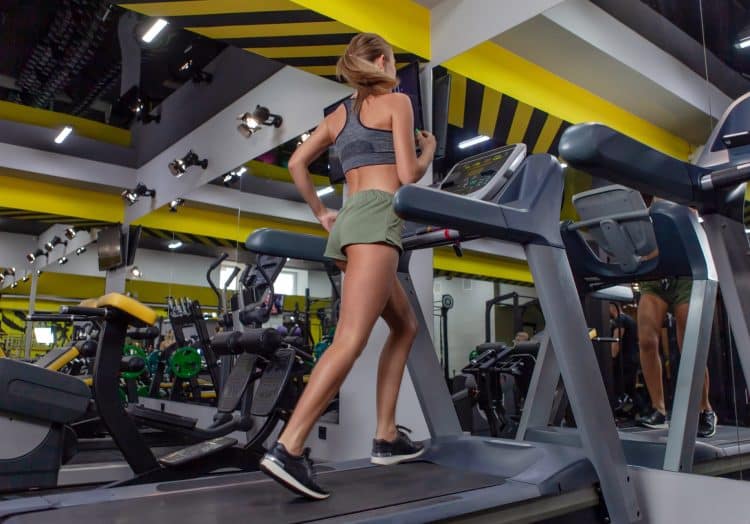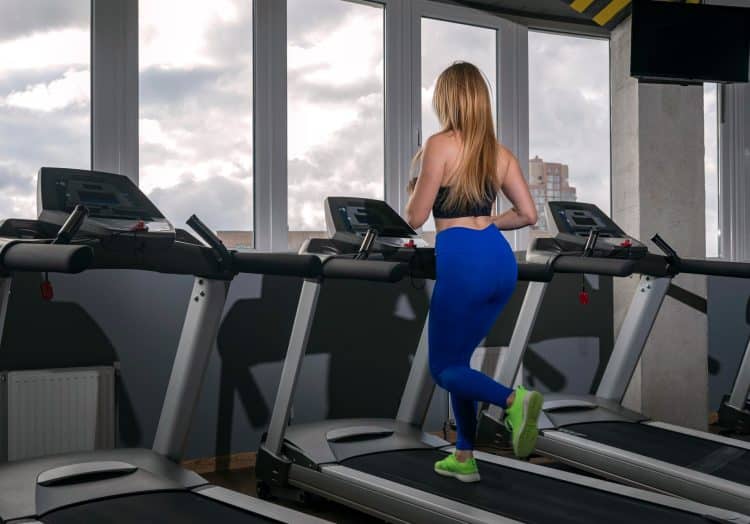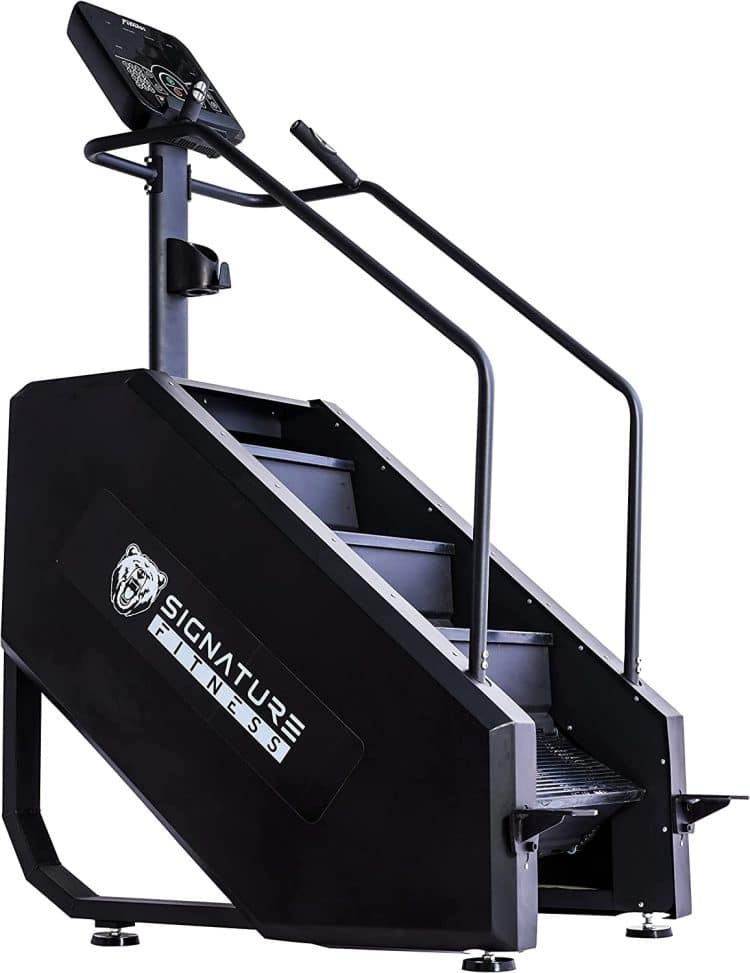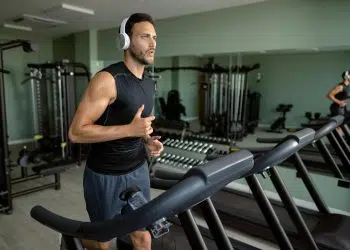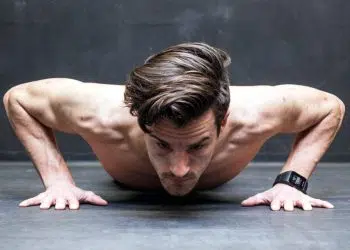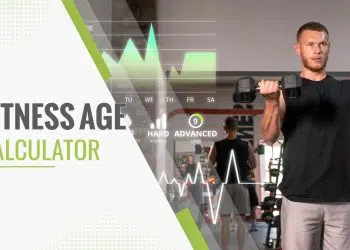A balanced fitness program includes spending time doing cardio. Whether you train in a commercial gym or set up your home gym, you will have plenty of cardio options. So, knowing which one to choose to get the best bang for your buck is crucial.
Two of the most popular cardio machines are the treadmill and the Stairmaster. Both are great for cardiovascular training, but which is better? Find out in this head-to-head comparison.
Stairmaster vs. Treadmill Overview
To make an educated decision between the Stairmaster and the treadmill, you need to know key facts about both. Here are the key areas we’ll cover:
- Use cases
- How to perform each exercise
- Muscles involved
- Advantages and disadvantages
- Muscle-building ability
- Calorie-burning ability
- Impact on joints
- Final verdict
Stairmaster vs. Treadmill Comparison
Here is everything you need to know to champion a Stairmaster vs. treadmill debate:
1. Use Cases: Stairmaster vs. Treadmill
Walk into any gym, and you’ll probably find the cardio area packed. More and more people are flocking to gyms to use treadmills, ellipticals, rowing machines, and Stairmasters to burn calories, shape up and improve their cardiovascular health.
Level Up Your Fitness: Join our 💪 strong community in Fitness Volt Newsletter. Get daily inspiration, expert-backed workouts, nutrition tips, the latest in strength sports, and the support you need to reach your goals. Subscribe for free!
Modern cardio machines have become mini entertainment centers with built-in screens, streaming services like Netflix, and workout programs to keep users engaged. However, you need to look beyond the bells and whistles if you’re looking to buy a single piece of cardio equipment for home use.
Things to consider when buying a Stairmaster or treadmill for home use:
a. Space
You probably have limited space in your home gym. Yet, your cardio machine will likely be one of the largest pieces of gear in your iron paradise. Both a treadmill and a Stairmaster are pretty bulky, though the treadmill is longer and takes up more space.
Stairmaster models vary slightly in size, but their typical dimensions are 58 inches (147cm) long x 34 inches (86 cm) wide x 89 inches (226 cm) high. A Stairmaster requires a ceiling height of ten feet. In comparison, the average dimensions of a treadmill are 77 inches (196 cm) long by 35 inches (89 cm) wide.
b. Cost
An average Stairmaster costs $4,900. On the other hand, a home treadmill can cost anywhere between $300 to $3,500. For between $300-700 you can purchase a no-frills budget treadmill. A middle-of-the-range treadmill will cost you between $800 and $1,800, while a high-end model with a wide running belt, top speed of 12 miles per hour, and advanced monitor will cost between $2,000-3,500.
2. How To Perform: Stairmaster vs. Treadmill
Exercising on a treadmill is relatively easier than on a Stairmaster. Here are some key tips to ensure that you are working out with the proper technique on each machine.
Treadmill Running Tips
Running on a treadmill takes some getting used to. Having the ground move under your feet requires more balance and coordination than running outdoors. Here are some tips to help you get it right:
- Run with your toes pointed forward: Avoid turning your foot out as you strike the ground as this can strain your knees. Start off slow until running with toes pointing forward becomes second nature.
- Maintain an upright torso: Engage your glutes, maintain a neutral lower back position, and keep your shoulders down and chest up. Don’t allow your body to slump as you get fatigued.
- Swing your arms: Use a natural back-and-forth swinging motion with your arms. Don’t allow your arms to cross the midline of your body.
- Do not hold onto the handrails: The rails are designed to help you get on and off the treadmill, not to be held while exercising. If you do, you won’t be able to maintain an upright position. Holding the rails also makes the exercise easier, reducing your calorie-burning potential and the overall effectiveness of your workout.
- Stride out: Run with a full, natural gait. Do not use short, stuttering steps. Avoid overstriding, or you’ll get ahead of your body’s center of gravity and create a braking force.
- Don’t get off when the treadmill is moving: Always wait until the running belt has stopped moving.
Stairmaster Tips
Make the most of the Stairmaster with the following tips:
- Maintain an upright spine: Tense your glutes, contract your core and keep your lower back naturally arched. Pull your shoulders back and chest up. Many people tend to hunch forward as fatigue sets in, putting stress on the lower back. If you feel that happening, squeeze your glutes and pull back your shoulders.
- Drive through the heel: Rather than just making contact with your toes, place your entire foot on the step and drive through your heel. This will emphasize the glutes rather than overloading the calves.
- Don’t hold on: Do not grab the safety rails as it will reduce the load on your muscles and the machine’s effectiveness.
- Go backward and forward: When you step facing the machine, the emphasis goes on the glutes and hamstrings. But when you turn around and face away from the machine, the emphasis goes on the quadriceps. Mix it up for a wholesome Stairmaster workout.
3. Muscles Involved
The treadmill puts primary emphasis on the lower body. Specifically, it works the glutes, hamstrings, quadriceps, and calves. At high speeds, you will also engage the core muscles.
Working out on the Stairmaster emphasizes the same muscles as the treadmill; the glutes, hamstrings, quads, and calves. By facing backward, you can place more emphasis on the quads.
4. Advantages and Disadvantages: Stairmaster vs. Treadmill
Every cardio machine has its pros and cons. Here are the main pros and cons of the treadmill and Stairmaster.
Advantages and Disadvantages of the Treadmill
Benefits of Treadmill
Using a treadmill has the following benefits:
- Bone strength: Treadmill walking and running have been shown to boost bone density [1].
- Heart health: Treadmills force your heart to work harder as it pumps more oxygen and nutrients to your muscles. This strengthens the heart so that it can pump more blood with every contraction.
- Core strength: The core connects the upper and lower body, keeping you stabilized and balanced as you run on a treadmill. Every stride you take strengthens your abdominals and obliques.
- Lower body strength: Treadmill running is a lower body-centric exercise. It directly works the quads, glutes, hamstrings, and calves. Running on a flat treadmill will improve your muscular endurance. To gain strength in the lower body, you should run on an incline.
Level Up Your Fitness: Join our 💪 strong community in Fitness Volt Newsletter. Get daily inspiration, expert-backed workouts, nutrition tips, the latest in strength sports, and the support you need to reach your goals. Subscribe for free!
Drawbacks of Treadmill
The cons of using a treadmill you should be aware of:
- High impact: Exercising on a treadmill is a high-impact form of exercise. You are stressing your ankle, knee, and hip joints with every stride. Modern treadmills use several techniques to reduce this impact, but it cannot be totally eliminated.
- Large footprint: A treadmill takes up a lot of space, making it a challenge for those with limited space in their home gym. Buying a foldable treadmill allows you to store it after use. However, most foldable treadmills are not as durable as those that do not fold.
- Not as challenging as outdoor running: When you run outdoors, your body has to negotiate the undulating terrain underfoot, better engaging the hamstrings and calves. Running outdoors also requires the hamstrings to complete the stride cycle. On a treadmill, the surface is completely flat and the motor completes the stride cycle for you. As a result, training on a treadmill is not as challenging as running outdoors.
Advantages and Disadvantages of Stairmaster
Benefits of Stairmaster
Given below are the advantages of training on a Stairmaster:
- Muscle strengthening: A Stairmaster does a better job of building lower body strength than a treadmill. You need to exert a downward force on every step. Over the course of a 20-minute workout, you will do this a thousand times, strengthening your quads, glutes, calves, and hamstrings.
- Low impact: Although it is an open chain exercise like the treadmill and requires lifting your foot off the platform, the Stairmaster is far easier on your joints. Rather than forcefully contacting the platform, you are stepping in a far more gentle way. As a result, it is a lot better on your ankles, knees, and hips.
- Increases bone density: Exercising on a Stairmaster is a weight-bearing exercise. As a result, it strengthens your bones and muscles [2].
Drawbacks of Stairmaster
The cons of using a Stairmaster:
- Not for HIIT-type training: Since training on a Stairmaster is not as intense as running on a treadmill, you need to work out for longer to get the same benefits.
- Expensive: A Stairmaster will cost more than double a high-end treadmill.
- Not as beginner friendly as the treadmill: Beginners tend to only use the front part of the foot and to hunch over as they progress through their workout on a Stairmaster. It also takes quite a lot of balance and coordination to get used to the elevator-type motion of the stepper.
5. Muscle-Building Ability
Both the Stairmaster and treadmill can help build lower-body muscle mass. Let’s find out which one does a better job.
The treadmill stresses the quadriceps, hamstrings, glutes, and calves. Running on a flat incline will increase your muscular endurance but won’t provide enough resistance for hypertrophy for most people. To add resistance, you will have to run on an incline and at a fast pace. This will, however, place some stress on your lower back.
The Stairmaster is a better option for building lower-body muscle mass. That’s because your legs are working harder on every step. In fact, each step could be seen as a mini leg press. In the course of an average Stairmaster workout, you’ll be doing thousands of these mini leg presses. The controls on the Stairmaster allow you to increase the speed, making your legs work harder.
While neither the treadmill nor the Stairmaster does a very good job of working the upper body muscles, the Stairmaster is the clear winner when it comes to building lower body muscle mass.
If you’re looking for the best cardio machine to work both your lower and upper body muscles, you should use a rowing machine. Check out our rowing machine vs. treadmill comparison here.
6. Calorie-Burning Ability
Most people use a cardio machine to burn calories and lose body fat rather than build muscle. The treadmill represents an excellent calorie-burning option. It allows you to get a long-lasting intense workout. Running at a constant fast pace for an hour on a treadmill can burn around 750 calories. If you elevate the incline of the treadmill, you will burn even more calories.
The Stairmaster is best for short intense bursts of activity. Most people will struggle to spend an hour on the Stairmaster. That’s because it is not as natural an exercise as running. You also will not burn as many calories on a Stairmaster. If you can keep going for an hour on a Stairmaster at moderate intensity, you would probably burn around 400 calories.
Few people actually push their cardio out to an hour. For most, a cardio session will last no more than 20 minutes. Doing a 20-minute high-intensity interval training session on a treadmill and a Stairmaster will deliver an effective calorie-burning workout. Once again, though, assuming you are using the same level of intensity, you will burn more calories on the treadmill. Both these exercises also help raise your metabolic level, aiding in burning calories hours after your workout.
7. Impact on Joints
Finding a joint-friendly form of cardio is important for many people. As we get older, our bone mineral density reduces, making us more vulnerable to joint injury. That makes it even more crucial to choose types of cardio that reduce the impact on our joints.
Running is one of the most stressful activities for the joints. Research indicates that between 19-79% of runners will develop an injury directly related to the activity. [3] While running on the road is worse than on a treadmill, it is still a joint-stressing form of exercise.
Modern treadmills incorporate advanced treadmill running belt technology to reduce joint impact stress. However, there will still be some joint stress due to the constant foot strike on the treadmill.
The Stairmaster is not as hard on your joints as a treadmill. Even though it requires you to lift your feet and bring them back down with each step, you are doing so far more gently than running on a treadmill. However, the continual climbing action of the Stairmaster can place excessive strain on your knees.
Keeping your workouts shorter than 20 minutes will help avoid excessive knee strain from using a Stairmaster.
Overall, the Stairmaster is more joint-friendly than a treadmill.
Final Verdict
Both the Stairmaster and treadmill are excellent for cardiovascular exercise. Both help improve cardiovascular fitness, burn calories, and build stronger and bigger muscles. The one you choose for your gym workout or as a home gym investment will depend on your training goals.
If your goal is to burn calories, improve cardiovascular health, build endurance, or lose body fat, you should go for the treadmill. On the other hand, the Stairmaster is a better option if you want to burn calories and lose body fat while building strength and muscle in your lower body. The Stairmaster is also the smartest choice for people looking for a low-impact cardio training option and those who are short on space in their garage gym.
References
- Troy, K. L., Mancuso, M. E., Butler, T. A., & Johnson, J. E. (2018, April 28). Exercise Early and Often: Effects of Physical Activity and Exercise on Women’s Bone Health. PubMed Central (PMC). Retrieved November 7, 2022
- Alghadir, A. H., Aly, F. A., & Gabr, S. A. (n.d.). Effect of Moderate Aerobic Training on Bone Metabolism Indices among Adult Humans. PubMed Central (PMC). Retrieved November 7, 2022
- van Gent RN, Siem D, van Middelkoop M, et al
Incidence and determinants of lower extremity running injuries in long distance runners: a systematic review British Journal of Sports Medicine 2007;41:469-480.


